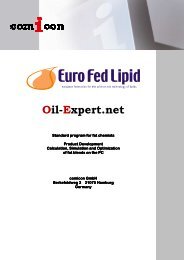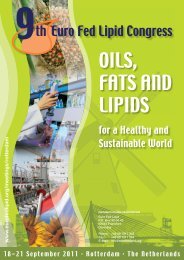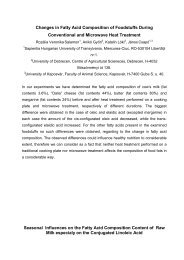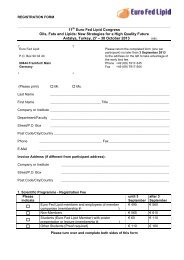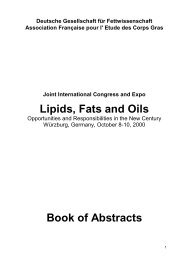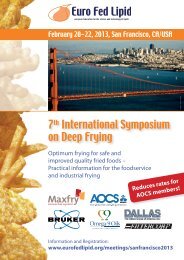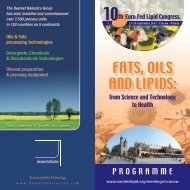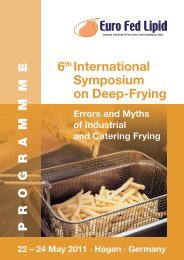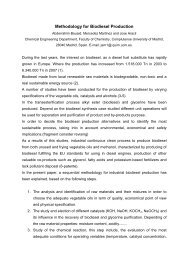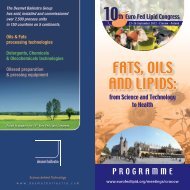Abstracts now available online - Euro Fed Lipid
Abstracts now available online - Euro Fed Lipid
Abstracts now available online - Euro Fed Lipid
Create successful ePaper yourself
Turn your PDF publications into a flip-book with our unique Google optimized e-Paper software.
Profiling of labile plant oxylipins by in situ derivatization with<br />
pentafluorobenzyl-hydroxylamine<br />
Birgit Schulze, Paulina Dąbrowska, Wilhelm Boland,<br />
Max-Plank-Institut für chemische Ökologie<br />
Jena, Germany<br />
Signaling compounds derived from the family of unsaturated C18-fatty acids play an<br />
important role during plant development and stress response. Although the oxylipins<br />
comprise a broad range of chemically diverse compounds, most previous studies focus<br />
on the analysis of classical phytohormones such as jasmonic acid and 12oxophytodienoic<br />
acid. We developed a rapid and reliable GC-MS-based method for the<br />
identification and quantification of oxylipins which includes labile and highly reactive<br />
compounds. A key feature of the method is the in situ derivatization of leaf extracts with<br />
pentafluorobenzyl hydroxylamine (PFBHA) yielding stable PFB-oximes that prevent<br />
degradation and rearrangements during sample preparation. The raw extract is<br />
partitioned with hexane and CH2Cl2 to separate less polar from polar compounds<br />
followed by aminopropyl solid phase extraction and derivatization with diazomethane<br />
and N-methyltrimethylsilyltrifluoroacetamide (MSTFA).<br />
Moreover, PFB-oximes exhibit characteristic mass spectra and can be analyzed with<br />
high sensitivity by negative ionization mass spectrometry (NCI-MS). This approach<br />
greatly facilitates the identification of unk<strong>now</strong>n oxylipins in complex plant matrices and<br />
allows monitoring of temporal and spatial changes of the oxylipin pattern in response to<br />
stress factors. High levels of oxylipins were observed locally in caterpillar damaged leaf<br />
tissue. Some of the oxylipins were already produced after mere mechanical wounding;<br />
whereas others required an additional action of herbivore-characteristic elicitors.<br />
Additionally, the in situ derivatization completely suppresses the isomerization of cis-JA<br />
to the less active trans-JA. After wounding, cis-JA is produced by de novo biosynthesis<br />
via the octadecanoid pathway. Then, cis-JA is slowly converted into its less active transisomer<br />
until a resting level is reached. Although substantial differences in physiological<br />
activity of various JA isomers have been reported, it is not entirely clear to which extend<br />
the epimerization is under enzymatic control or occurs spontaneously.<br />
P20




